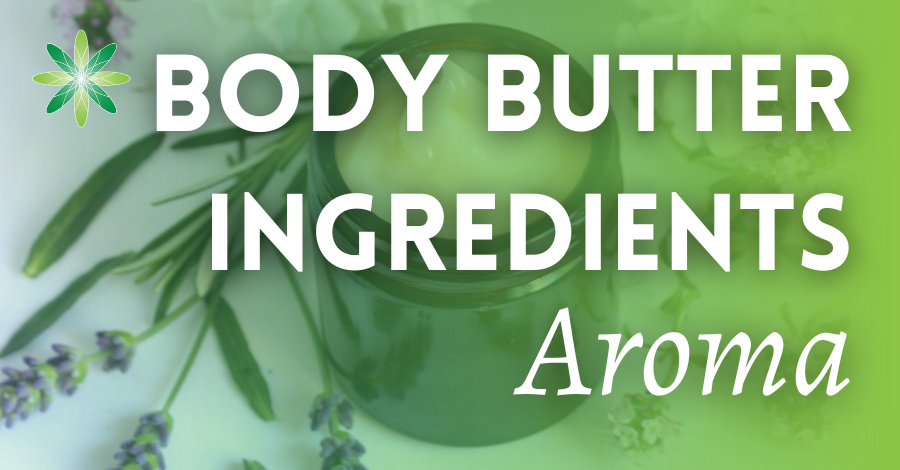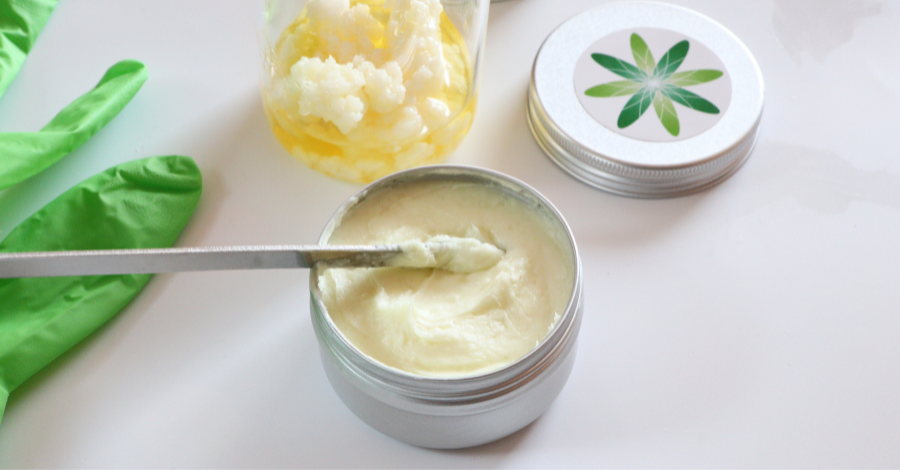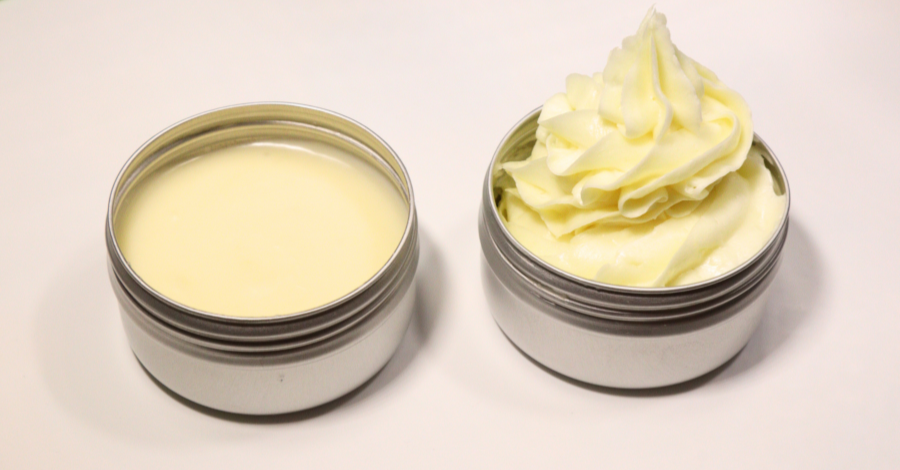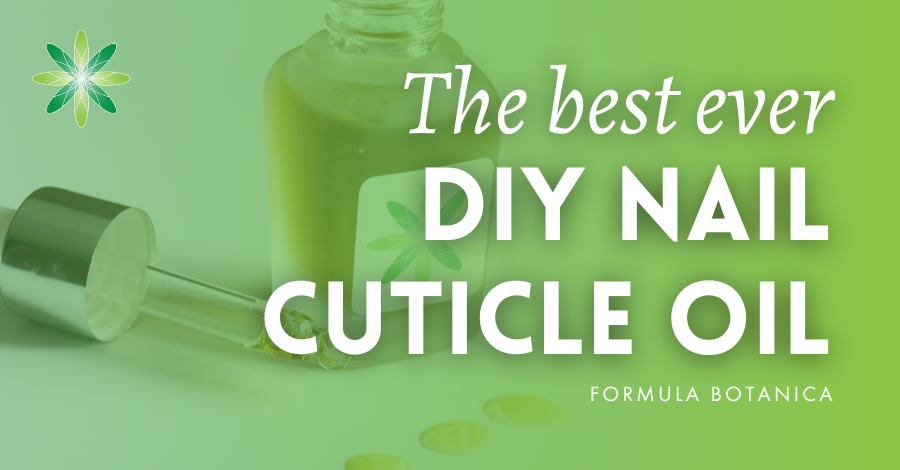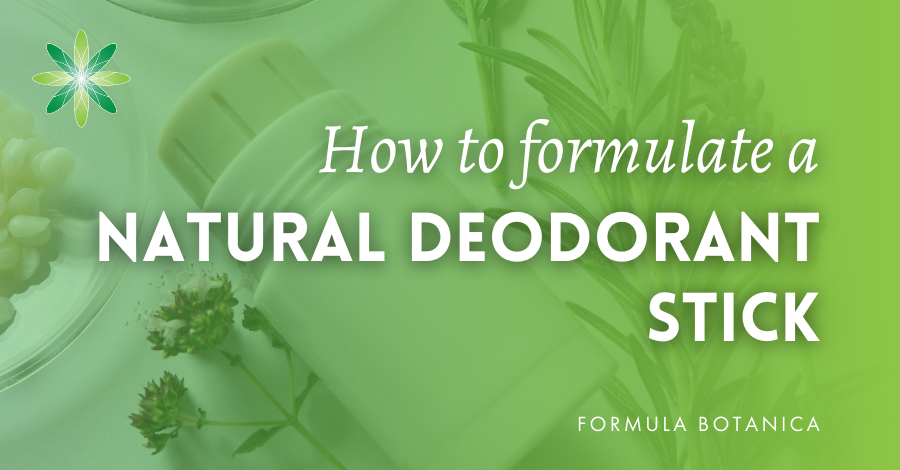[Updated: 09/01/24]
Body butter is a skincare product designed to provide intense moisturisation and nourishment to the skin. It is a thick, creamy substance that is typically used to hydrate and soften the skin, leaving it feeling smooth and supple.
Body butters are especially beneficial for dry or very dry skin, as they contain rich ingredients that help to lock in moisture. When the skin needs fat-rich products to protect it against cold and dry weather, body butters are the ideal skincare to meet this need.
We’ve suggested a lot of options for ingredients to include so you can have fun tailoring our simple body butter formulation to suit your needs and the oil and butters you have in your store cupboard. Use the links to read more about these options:
Body butter formulation tips
As simple as it might sound, formulating a body butter does need some care and attention, even if it is a waterless (anhydrous) skincare product that doesn’t usually need a preservative.
The key to a formulating the ideal body butter is to create a beautiful sensorial experience. Your body butter needs to have the optimal thickness and skin feel with a pleasant aroma in tune with the idea of a nourishing cosmetic. Graininess, a strange colour, an overpowering aroma, or a draggy, too thick or too runny texture are all signs of a less than ideal formulation concept or errors in your method or manufacturing technique.
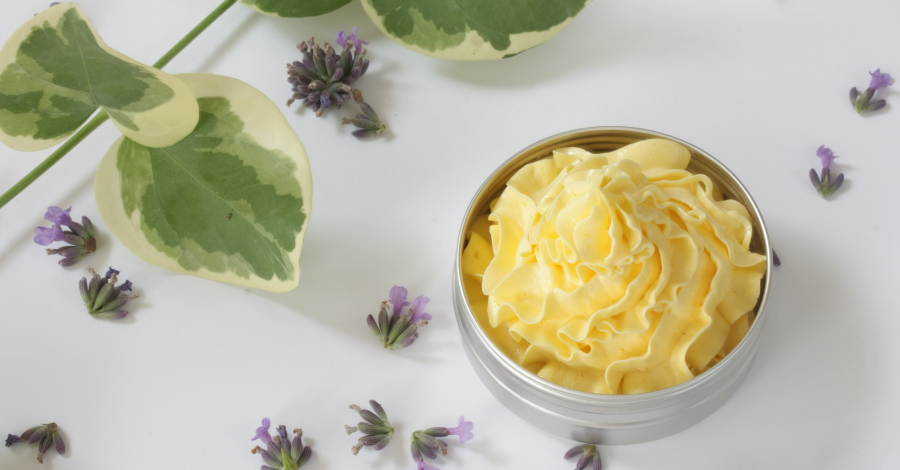
- One type of plant-derived butter or combination of different butters.
- One or more botanical oils with skin benefits to suit your body butter theme.
- Plant-based extracts, if desired, to add a high-performance boost to your body butter.
- Thickeners to create the ideal viscosity and skin feel.
- An antioxidant to help increase the shelf life and stability of the body butter.
- Aroma / essential oils for sensorial and also skin beneficial effects.
- Preservative – usually not required, but an oil-soluble one could be added.
Let’s now look at some common and easy-to-source ingredients you can choose for your body butter formulation.
Top ingredients for your body butter formulation
1. Botanical butters
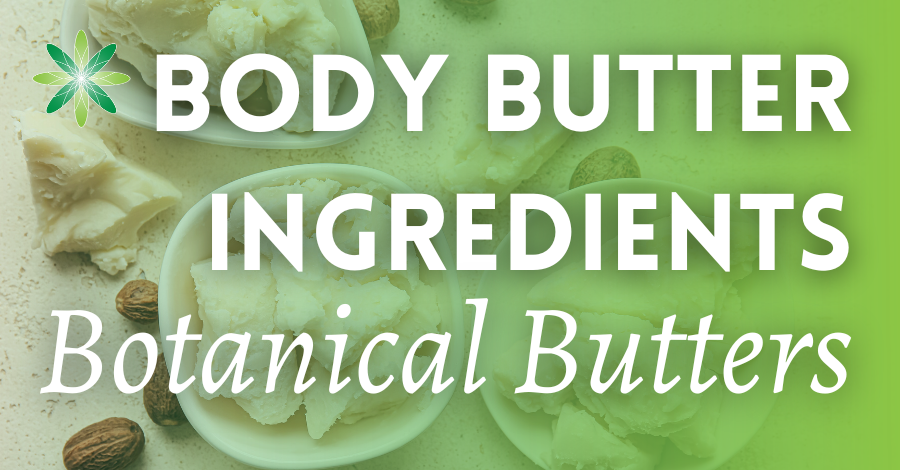
For inspiration on which to use, see:
5 Amazonian butters for organic skincare formulations
10 Natural African skincare ingredients
Those we formulate with most frequently at Formula Botanica include:
Shea Butter: Extracted from the nuts of the shea tree (Vitellaria paradoxa, or Vitellaria nilotica), shea butter is known for its deep moisturising properties. It contains fatty acids and vitamins that help nourish the skin.
Shea butter is a very common foundation ingredient in body butters but it needs some careful handling at the melting and blending stages of manufacture in order to avoid graininess. For the full lowdown on working with shea, see our post:
Cocoa Butter: Derived from cocoa beans of the cocoa tree (Theobroma cacao), cocoa butter is rich in antioxidants and has a velvety texture. It is known to soothe and moisturise the skin.
Mango butter: Extracted from the seeds of the mango fruit (Mangifera indica), this butter is known for its creamy texture and rich emollient properties. Mango butter is a solid at room temperature, but melts upon contact with the skin, making it easy to apply.
Illipe butter: Derived from the seeds of the Shorea stenoptera tree, this is a plant-based fat known for its rich and creamy texture. It is solid at room temperature and has a high melting point, making it beneficial in giving texture to the formulations.
Cupuaçu butter: Cupuaçu butter is a plant-derived fat obtained from the seeds of the cupuaçu tree (Theobroma grandiflorum), native to the Amazon rainforest. This butter has a smooth and creamy texture, similar to cocoa butter, and is rich in fatty acids, including oleic, palmitic, and stearic acids. Cupuaçu butter is known for its exceptional moisturising properties.
Murumuru butter: This plant-based fat is extracted from the seeds of the murumuru palm tree (Astrocaryum murumuru), which is also a native of the Amazon rainforest. Murumuru butter is characterised by its firm and brittle texture at room temperature, melting easily upon contact with the skin.
2. Plant-derived oils
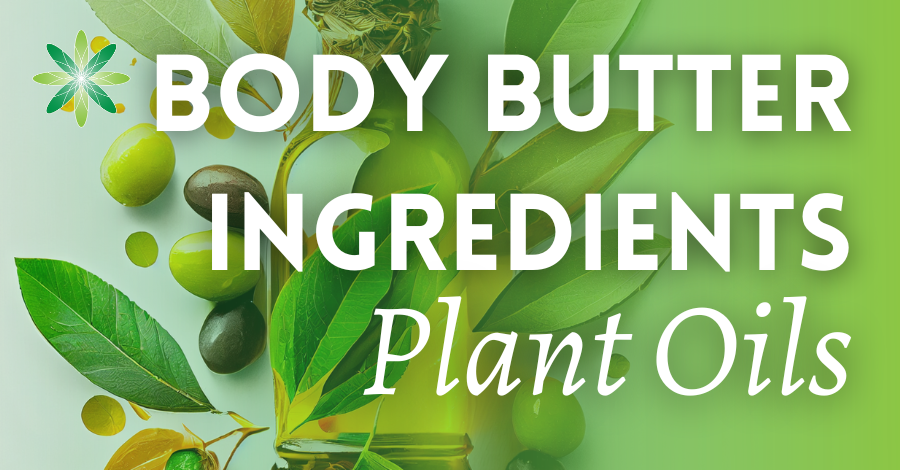
For some ideas on botanical oils to include, see our guides:
10 botanical oils every formulator needs
10 best zero waste oils for skincare and haircare
10 best winter carrier oils for skin and hair
Some of the most popular for body butter formulation include:
Sweet almond oil: This is a natural oil extracted from the seeds of the sweet almond tree (Prunus dulcis). It is renowned for its mild, nutty aroma and a light, non-greasy texture. Sweet almond oil is rich in monounsaturated fats, vitamin E, and essential fatty acids, making it a popular and economical choice for skincare. Known for its moisturising and nourishing properties, almond oil is used to soothe and soften the skin, helping to alleviate dryness and irritation.
Apricot kernel oil: This is a lightweight, pale-yellow oil derived from the kernels of apricots (Prunus armeniaca). It has a mild and slightly nutty aroma and is rich in essential fatty acids, and vitamins. This oil is easily absorbed, making it suitable for various skin types, including sensitive and dry skin.
Sesame seed oil: A versatile and richly-flavoured oil extracted from sesame seeds (Sesamum indicum), this oil has a distinct nutty taste. In addition to its culinary uses, sesame seed oil is valued for its various skincare benefits. As a lightweight oil that is easily absorbed by the skin, it is suitable for massage and skincare formulations like our body butter.
Jojoba oil: Closely resembling the natural oils produced by the skin, it makes an excellent moisturiser without clogging pores. For a detailed look at the skin benefits of jojoba, see:
Rice bran oil: Extracted from the outer layer of the rice grain, known as the bran, this is a versatile oil valued for its skincare benefits. Rich in antioxidants, vitamins, and fatty acids, it helps nourish and moisturise the skin. The oil is light and easily absorbed, making it suitable for different skin types.
Coconut oil: Often included for its moisturising and antibacterial properties, coconut oil helps contribute a pleasant scent to the body butter. Discover more on the properties of coconut oil in our post:
Babassu oil: This oil is extracted from the seeds of the babassu palm tree (Orbignya oleifera) that is native to Brazil. It is a light, non-greasy oil with a mild, pleasant aroma. Babassu oil is rich in lauric and myristic acids, similar to coconut oil, that provide moisturising and emollient properties.
There are many more other excellent oils you could include in your body butter formulation, depending on your budget and overall theme, such as rosehip, avocado and evening primrose oils.

Do you want to learn how to make organic skincare that works?
Our award-winning foundational natural skincare course teaches you how to formulate organic skincare products and launch the beauty brand of your dreams. Click Here
3. Plant-based extracts (oil-soluble)
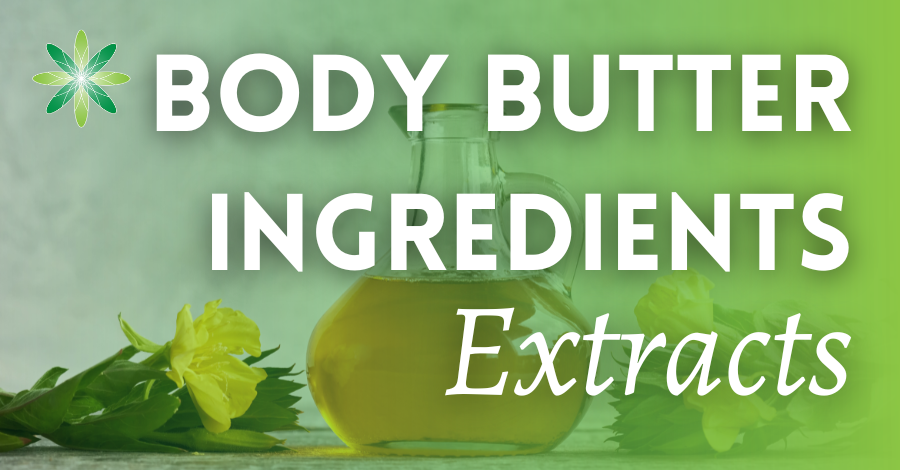
These are usually macerates in sunflower seed oil or CO2 extracts. Common examples include calendula, sea buckthorn, evening primrose and St John’s Wort. These should be added below 40°C so as not to damage their inherent skin-beneficial properties.
Find out all about macerates, and how to make your own in our post:
4. Thickeners for skin feel and viscosity

5. Antioxidants for stability
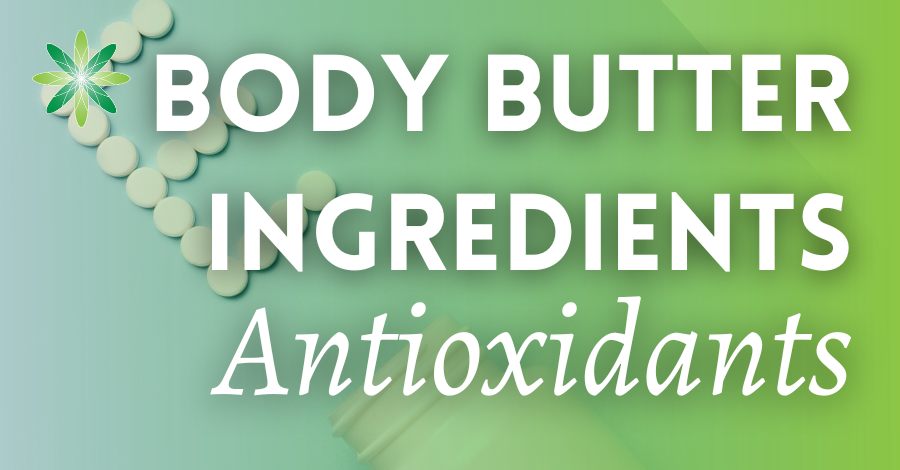
When exposed to oxygen in the air, natural fats undergo some chemical processes that change their chemical structure and properties. These are triggered often by external conditions such as increased temperature, light or the presence of heavy metals. This results in the degradation of the lipids, the development of an undesirable scent and changes in colour to compromise the overall quality of the product.
We know this process under the more familiar name of rancidity. Different oils and butters have different resistance to oxidative processes, but adding an antioxidant is always recommended. Tocopherols (usually included as vitamin E) are a large group of molecules that can reduce free radicals and mitigate the effect of oxidative processes in the formulation. Keeping the product in a dark, air-tight container and at a regulated temperature makes also a significant contribution to prolonging the shelf life.
5.Preservative – do you need one?
Body butters that are formulated without additional water content are stable even without using a preservative, but should be stored in a moisture-proof container to prevent water condensation inside the packaging. An oil-soluble preservative may be added as a precaution if the body butter is applied with fingers and exposed to damp bathroom conditions.
6. Aroma / Essential Oils – for sensorial experience
You may like to include some essential oils for fragrance and additional skincare benefits. Common choices in body butter formulations are lavender, geranium, or citrus oils. For these ingredients is important to follow your oil suppliers’ recommendations and comply with the International Fragrance Association (IFRA) standards, which regulate the use of essential oils in cosmetic products to ensure their suitability and safety, and EU legislation covering allergens in cosmetics, many of which derive from essential oils.
See our podcast on Essential Oil Safety. These posts are also useful to read in relation to essential oil use:
Why you should never measure essential oils in drops
How to read safety data sheets
Simple body butters: creamy and whipped
Now we’ve gone through a nice list of ingredients you can include and what they bring to your formulation, let’s get formulating.
We are going to keep to our Keep-It-Silly-Simple (KISS) principle in this formulation so everyone from first-time beginner formulators upwards can make this really fast.
As a bonus, and for those who like a bit more of a challenge, we’re offering two types of body butter processing to choose from:
- Creamy method – in which you simply melt all the solid ingredients and blend; and a
- Whipped method – for a lighter and fluffier texture.
For the whipped method, you need to follow the creamy butter method, but after step 3, put the whole blend into the fridge for a few minutes (e.g. 15-20 minutes) and then start to whip, using a hand mixer, until it is homogeneously smooth, fluffy and uniform. We explain this in detail below, but you need to plan ahead if opting to whip.
Our formulation: 7-ingredient easy body butter
Makes: recommended trial batch size: 100g.
Formulation: a hot process, anhydrous formulation.
Time taken: 15 minutes (more if whipping the butter).
Level: beginner-level formulation to personalise and adapt. If this is your first body butter, we recommend that you keep it simple and stick to a small number of oils and butters to get used to the method and to learn about your ingredients.
| Phase | Ingredients | INCI | Weight (g) |
| A | Babassu oil | Orbignya oleifera seed oil | 11.00 |
| A | Cocoa butter | Theobroma cocao seed butter | 4.00 |
| A | Shea butter | Butyrospermum parkii (shea) butter | 52.00 |
| B | Avocado oil | Persea gratissima (avocado) oil | 26.80 |
| B | Vitamin E | Tocopherol | 1.00 |
| B | St John’s Wort extract in sunflower oil | Helianthus annuus seed oil, Hypericum perforatum (flower/twig) extract | 5.00 |
| C | Ginger essential oil | Zingiber officinale (root) oil | 0.20 |
| Total: 100.00 |
Equipment:
- Scales
- Glass beakers / stainless steel bowls
- Hot plate
- Thermometer
- Water bath
- Spatulas, stainless steel spoons and pipettes
- Protective gloves
- Suitable container – lidded, wide-neck pot
How to Make a Body Butter

Step 2. After this blend is melted, stop heating and add the avocado oil, the extract and tocopherol and blend gently with a spatula or glass rod.
Step 3. Continue gentle blending as the blend cools down. At about 35 degrees Centigrade add the essential oil. Now follow the next instructions depending on whether you wish to make a creamy or whipped body butter.
How to Make a Creamy Body Butter
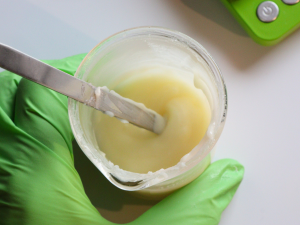
As the butter cools down, the viscosity increases. Continue stirring until the butter reaches a consistency where you can make traces with your spatula. This is the consistency of our butter at this point. If opting for a whipped butter, continue with the method below once the body butter has started to solidify.
At this point pour the butter into the jar and bring it into the fridge. Using this procedure, all of your ingredients cool down simultaneously and there is no chance of crystallisation for shea butter. The butter will solidify to a nice and smooth consistency without that dreaded grittiness.
How to Make a Whipped Body Butter
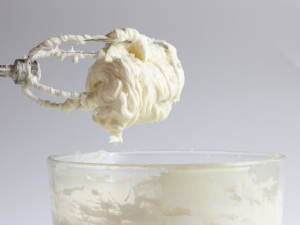
Leave both butters for some 12-24 hours in the fridge. After that, take them out and leave them at ambient temperature. Compare their appearance, texture and skin feel after another 24-48 hours.
These are our two versions of the body butter:
The butter on the left is the creamy one. The other is whipped. Both butters are smooth, have no greasiness and impart a silky feel to the skin. None of them are gritty or grainy. The whipped body butter was piped into its container using a patisserie decorating tip. This makes it look picture perfect. You can choose how you’d like to present your body butter
Do let us know in the comments how you got on making this easy body butter formulation and which processing method you prefer and enjoy using the most.
Suggested suppliers
Many of the suppliers below ship internationally. We have given their home country base.
Aromazone (EU).
Aromantic (UK)
Alexmo Cosmetics (EU)
Manske (EU)
Soap Kitchen (UK)
Elemental (EU)
Lotioncrafter (USA)
Essential Wholesale (USA)
O&3 – the Oil Family (UK/EU)
Go Native (New Zealand)
Naturally Balmy (UK)
Soap & More (Canada)
FREE TRAINING
Learn how to become an
Organic Skincare Formulator
FREE TRAINING
How to become an
Organic Skincare Entrepreneur
FREE TRAINING
How to become an
Organic Skincare Entrepreneur
Leave us a comment

Miroslava is a former grading tutor at Formula Botanica. She has a Ph.D in neuroscience, expertise in biology and chemistry, and a lifelong passion for natural cosmetic formulation.


